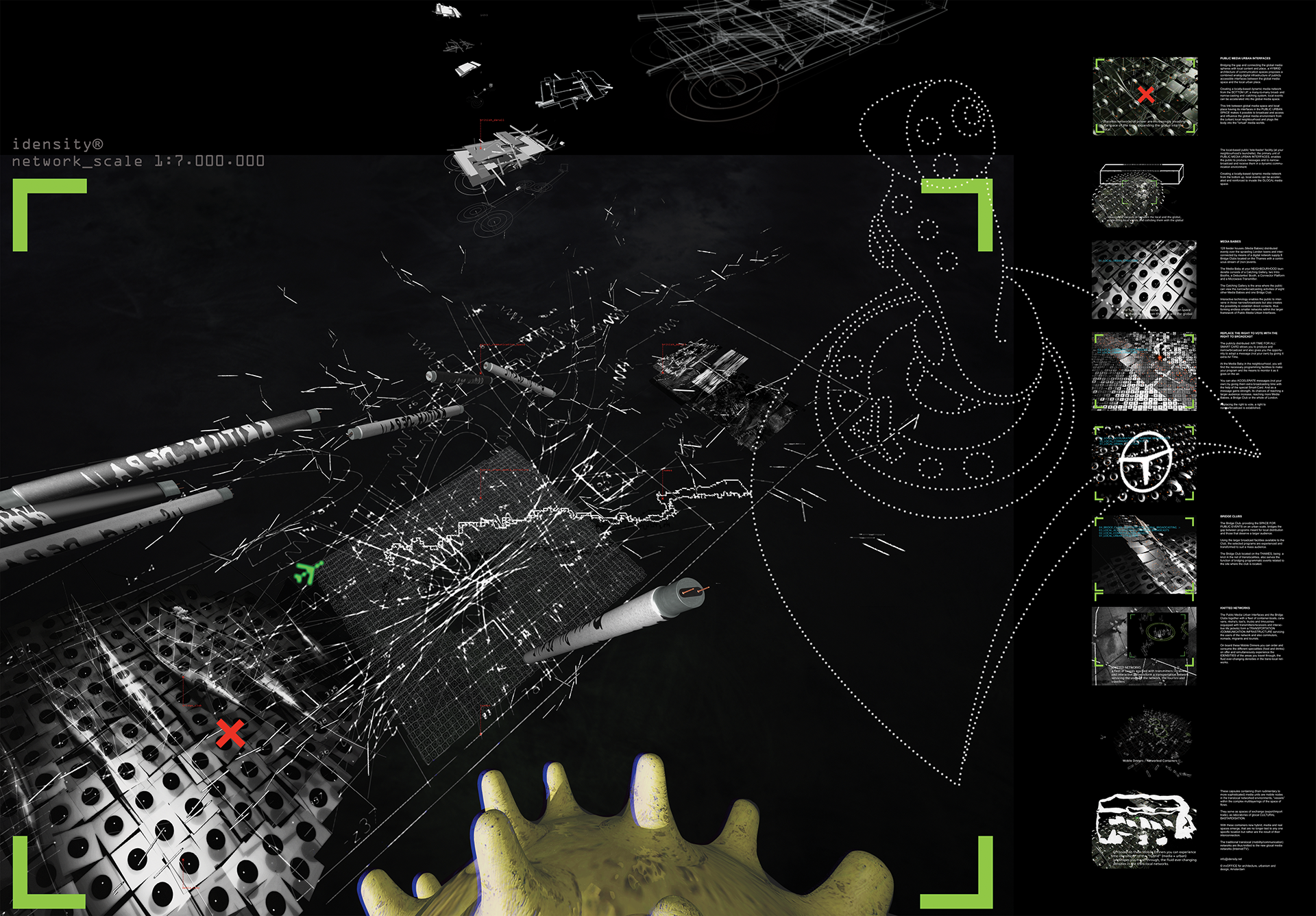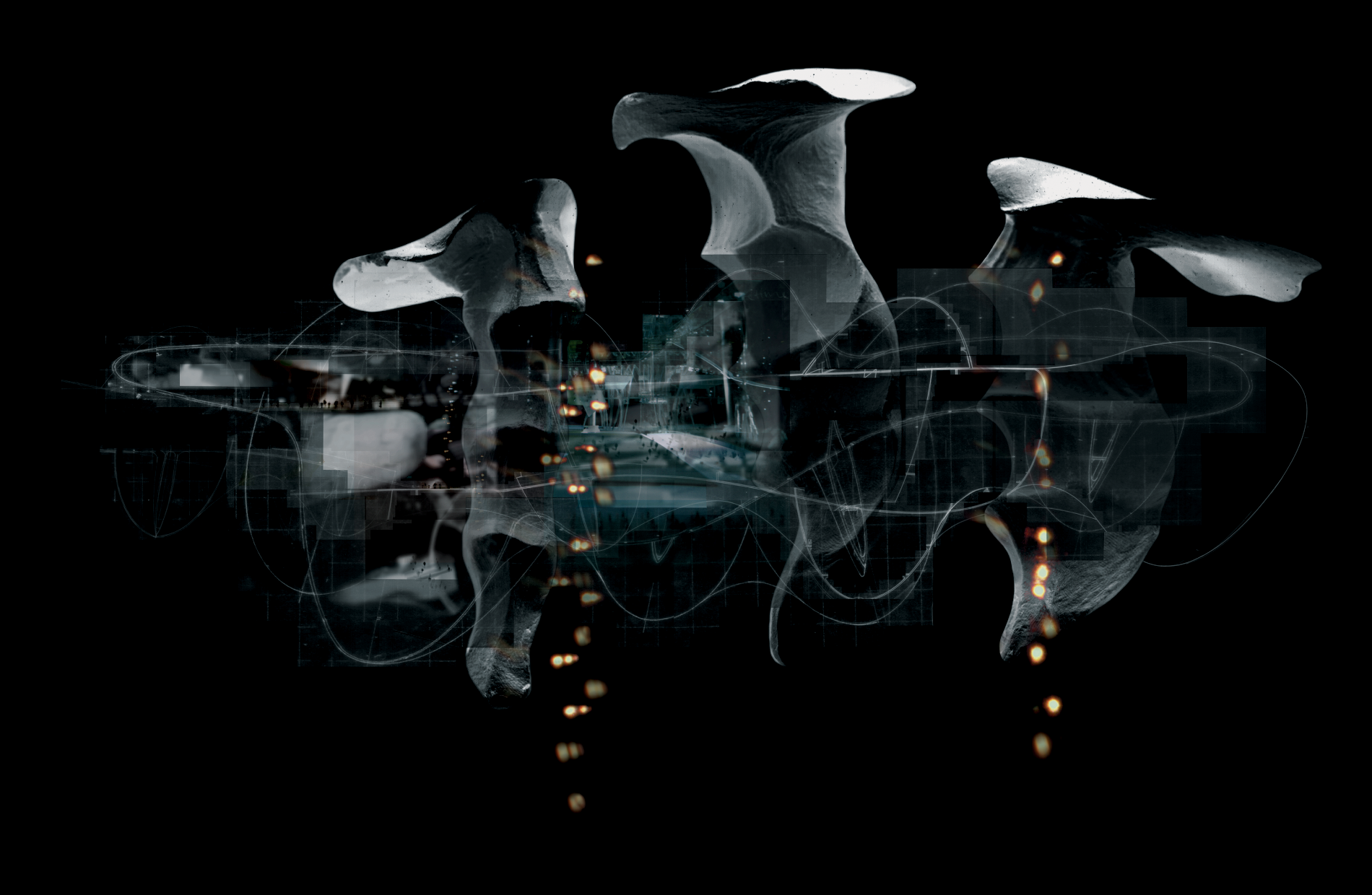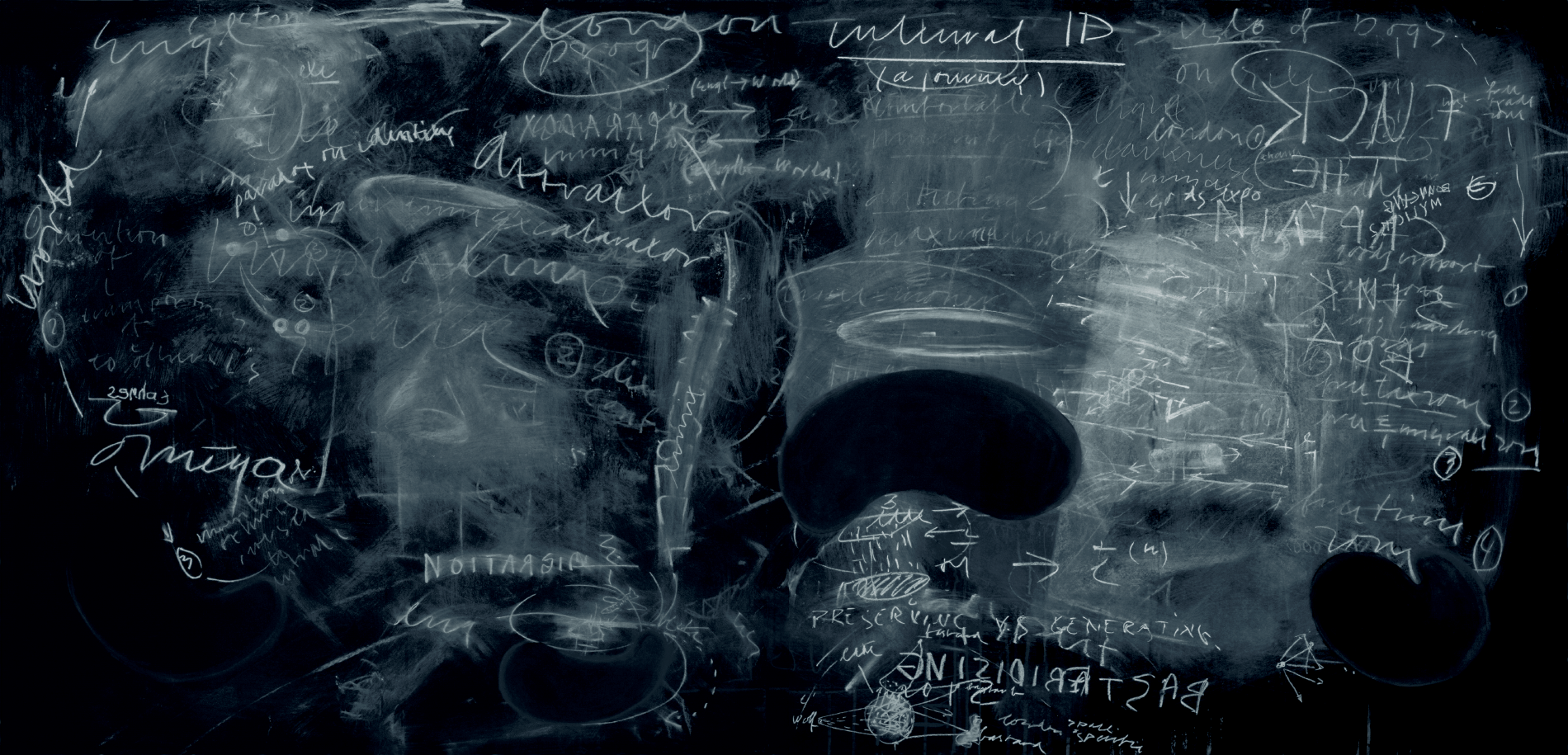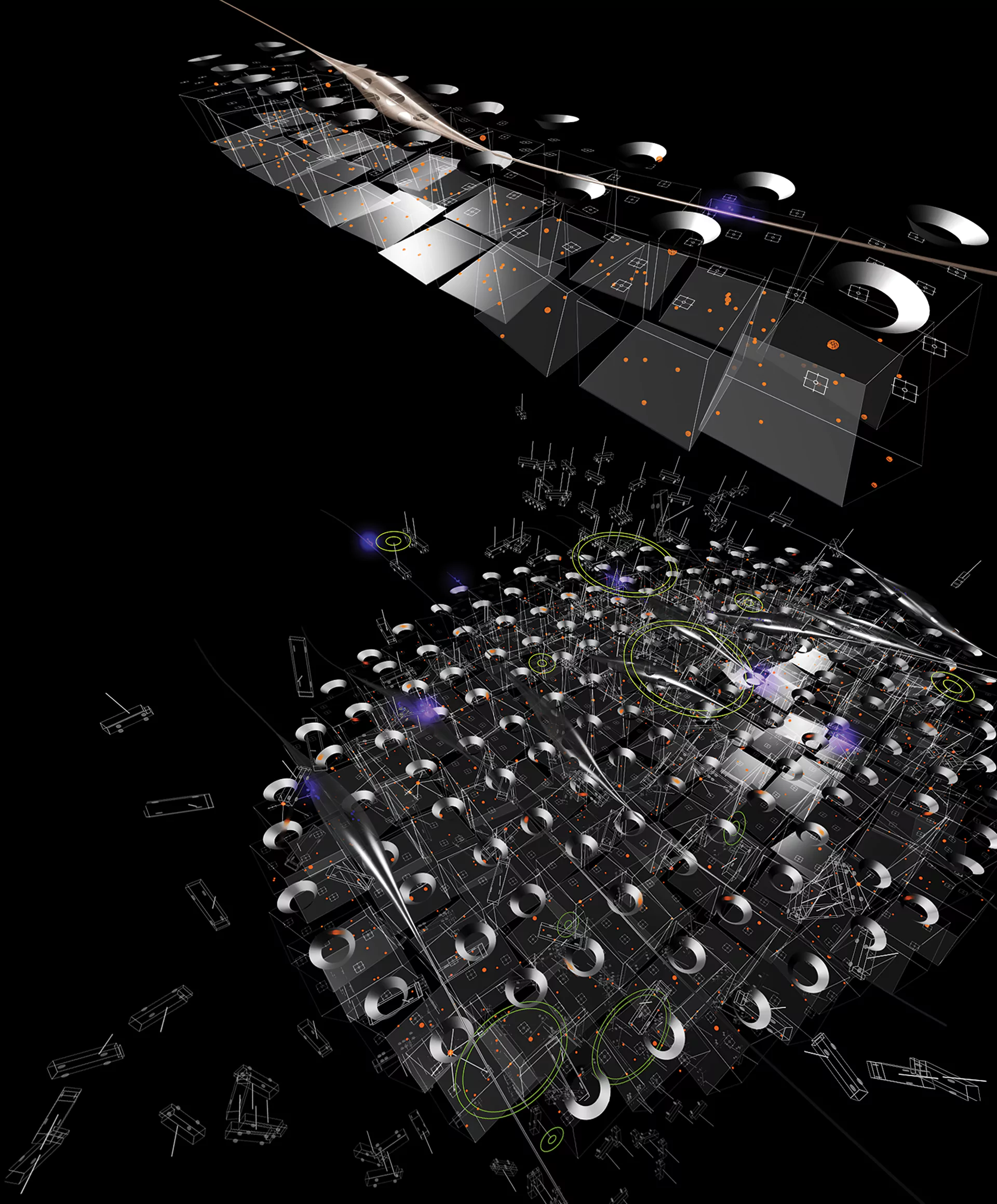Public urban space and the “space” of communication networks are usually considered to be competing, even mutually exclusive frameworks for social interaction.
Traditional functions of urban space are being taken over by telecommunication networks.
In fact, the traditional functions of public urban space are being taken over by telecommunication networks, their input/output devices implanted in (private) interiors.
Publication Media & The City @ de Architekt, den Haag, the Netherlands, July 1997
Introduction Harm Tilman, editor in chief @ de Architect, den Haag, the Netherlands, @ de Architect, den Haag, the Netherlands, Juli 1997
Soft
City
Public urban space and the “space” of communication networks are usually considered to be competing, even mutually exclusive frameworks for social interaction. In fact, the traditional functions of public urban space are being taken over by telecommunication networks, their input/output devices implanted in (private) interiors.
Architects and urbanists confronted with these developments tend to adopt an attitude of blind refusal: the prospects offered by electronic media are ignored or simply denied, because in their view, media space seems to dissolve the “urban public space”. On the other hand, the proponents of cyberspace project all sorts of simplistic expectations, anticipating the transfer of urban functions in the “soft” cities of tomorrow.
“Soft” cities, thus claimed to be “democratic”, are becoming increasingly exclusory. Public space is imploding, not just in its in its urban component, but also in its media. The agenda is being set for the privatisation of the electronic mass media spaces. However, at this turning point, on the threshold of the era of world (market) domination by the software giants, there is still a chance to establish a more public dimension in the communication environments.
The gap between the immaterial, exclusive media spheres (Internet, television, etc.) and the dismembered urban sprawls is widening; the polarisation of global and local space is increasing. A strategy to reinforce the significance of public space has therefore to deal with at least two “public”, the global and the local public, by creating environments where local and global public space can fuse and interact.

Public
Interfaces
To bridge the gap and connect the global media spheres with local urban content and place, a hybrid architecture of communication spaces proposes a new, public, combined analog-digital infrastructure: “Public Media Urban Interfaces”, publicly accessible interfaces between the global media space and the local urban place.
This project by Hybrid Space Lab proposes an alternative scenario for the interplay of mass media in order to reinforce the function of public urban space. It emphasises the role of the public in an increasingly privatised society and occupies the vacuum in between the local and the global. It develops a hybrid urban network-space, a fusion of media space and urban space. The products of this alliance of urban and media networks are bastards: ambivalent spaces that are at the same time analog and digital, virtual and material, local and global, tactile and abstract.
Hybrid Space Lab represents an interdisciplinary field of design, exploring the dynamic interaction of urbanism and the space of mass media and communication networks; “Soft Urbanism”, dealing with the “soft” aspects of the city, not only intervenes in the realm of infrastructures, but also adopts their concept and paradigm. By supplying networks, “Soft Urbanism” creates new fields of possibilities and frameworks for self-organisational processes.

A demo project, exploiting London’s urban tensions and structure unfolds strategies and visualises aspects of this investigation. It speculates about processes of urban transformation and economic (empowering) strategies, confronting a working hypothesis with the idiosyncrasies of a specific urban situation. It creates a programmatic framework to develop architectural tools, tracing and coding these hybrid analog-digital spaces.
A local-based public interface, the Media Baby, is the instrument that seduces its public into exploiting the television medium, maximising its potential spontaneity by hijacking the publics imagination. The name Media Babies stands for the seeds of communication (environments) as well as for the public neighbourhood feeder houses (hybrid analog-digital environments) from which the Media Babies will be broadcast. One hundred and twenty-eight feeder houses distributed evenly over the sprawling London towns and interconnected by means of an ISDN network supply eight Bridge Clubs located on the Thames with a continuous stream of (non-)events. The Media Baby at your neighbourhood launderette consists of a Catching Gallery, two Intro Booths, a Debutantes’ Booth, a Connector Platform and a Microwave Transmitter. The Catching Gallery is the area where the public can view the narrow/broadcasting activities of eight other Media Babies and one Bridge Club. Interactive technology enables the public to intervene in those narrow/broadcasts but also creates the possibility to establish direct contacts, thus forming smaller networks within the larger framework of Public Media Urban Interfaces.
The Bridge Club bridges the gap between programs meant for local distribution and those that deserve a larger audience. It forms the core of a North-South line linking eight Media Babies on each side of the river, connecting the north with the south of London. The Bridge Clubs are sophisticated and enlarged versions of the Media Babies providing the space for public events on an urban scale. One of the additional facilities they have is the Selector Platform where the Selection Ritual takes place. Using the larger broadcast facilities available to the Bridge Club, the selected programs are experienced and transformed to suit a mass audience. The Bridge Club also serves the function of bridging programmatic events related to the site where the club is located. For example, the Hungerford Bridge Club on certain days (or nights) functions as a Debutantes’ Ball in relation to the nearby Waterloo Station (Continental connection).
The publicly distributed ‘Air Time for All’ Smart Card allows you to produce and narrow/broadcast and also gives you the opportunity to adopt a message (not your own) by giving it extra Air Time. At the Media Baby in the neighbourhood, you will find the necessary programming facilities to make your program and the means to monitor it as it goes on the air. You can also accelerate messages (not your own) by giving them extra broadcasting time with the help of the special Smart-Card. And as a message gains strength, its chances of reaching a much larger audience increase, reaching more Media Babies, a Bridge Club, the city or even the whole country, Europe and the rest of the world.
Replacing the right to vote, a right to narrow/broadcast is established. Once you have produced your programme, instant satisfaction is guaranteed. Check out the Connector Platform and see what reactions your program provokes in the network: get a five-dimensional overview of the life cycle, the pains and the joys of your message.

In architecture’s role of defining and materialising the spaces for social interaction, designing the relationship between the physical and digital public domain is becoming more and more of a challenge: investigating the relation and interconnection between the “soft” city with its finite material counterpart, the living environment, speculating about interfaces between the “virtual” and the material (urban) world and designing hybrid (analog-digital) communicational spaces.
Soft Urbanism deals with information/communication processes in public space, the soft aspects overlying and modifying the urban sprawl: the invisible networks acting as attractors, transforming the traditional urban structure, interweaving, ripping open and cutting through the urban tissue, demanding interfaces.
Soft Urbanism not only intervenes in the realm of infrastructures, but also adopts their concept and follows their paradigm. It brings an inherently flexible approach by expanding the field of social interaction and opening new paths of urban development. Soft Urbanism conceives the city as an organic entity, as “proteinic chains of networks”. Soft Urbanism is therefore not about shaping, inscribing or determining places, but about creating frameworks which allow and enhance a variety of unpredictable developments.
Urbanism today is caught up in the dilemma of either trying to realise the dream of the omnipotence of planning or accepting powerlessness in the face of the forces of the property market: on the one hand, the modernist belief in scientific methods of determination and control of the urban phenomena violating entire cities, on the other hand, the neoliberal positions giving in to the interests of privatisation and declaring the dynamics of the market to be the only legitimate determinants of urban developments. Facing up to the consequences of both positions today, Soft Urbanism develops an alternative strategy of intervention to reintroduce programmatic speculations about the public domain in urbanism.
The interventions will not be about control and determination, but about expanding infrastructures, frameworks for processes of self-organisation. “Soft” strategies will be “bottom-up” strategies: rather than first defining the global result of the interaction and then determining the necessary relation between the elements in order to produce that interaction (which would be a “top-down” approach), simple rules for a set of independent elements will be developed and that which emerges from the interaction of these elements is aleatory. According to biological models, these fields of interaction of plural forces will serve as a reservoir for the selection processes needed for urban transformations.
A method for extrapolating existing reality to unfold its possibilities and force creative accelerations will release spores and create paths as yet unknown. (Speed, acceleration, but not control of direction.) The spores (Babies) will infect different environments by adapting, mutating and transforming them.

In the contradictory dynamics of our contemporary urban environment, with its opposing tendencies toward concentration as well as decentralization, functional mixing as well as segregation, traditional notions of spatial distinctions are losing their validity. In this fragmented urban landscape, categories such as „center“ as opposed to „periphery,“ „landscape“ as opposed to „city,“ and „separation of functions“ into living, working, and recreation have become irrelevant.
The polarity of the private (residential) and public spheres has been abolished. The public and private (residential) environments are increasingly blending and blurring through the merging of media and „real“ space, for example in the publicly broadcast private spaces of „reality TV“ programs, through the media presence of wars that invade the peacefulness of our private living spaces, and in the private (communication) space that the user of the cell phone creates around him in the middle of the public urban environment.
To capture this fusion, this overlap and interaction of media and „real“ urban space, the new term „Idensity™“ is introduced. „Idensity™“ does not distinguish between information/communication networks and the urban built environment and offers an integrated model for dealing with hybrid (media and „real“) space in the information and communication age.
It is a compound term, a combination of the word „density“ (density of real (urban) and „virtual“ (media) communication areas (density of connections) and the word „identity“.
„Idensity™“ can be applied to guide urban development processes. „Idensity™“ integrates the concept of „density“ (density of connections, density of physical and digital infrastructure, density of communication spaces, etc.) with the concept of identity („city image“ campaigns, „urban branding“). Therefore, it can contribute, for example, to the understanding of processes of separation and spatial segregation between urban sub-areas that have characteristics of ‚global‘ quality and that can be considered as part of a network of ‚global‘ urbanity, and other (parts of) cities, sometimes located in close proximity, that are losing importance and disappearing from global mental maps.
It is not a mere addition of the two terms „density“ and „identity“, but rather a fusion that inverts „identity“ and connects it with communication: by defining „identity“ through networking.
The term therefore refers not only to the „distinct identity, particularity, individuality of traditional places or sites“ (such as centers and monuments), but also describes an area of overlapping (communication) spaces: the ever-same realm of chain stores, the symbolic realm of traditional buildings housing stores, the media realm of teleshopping, the communication realm of global mobile technology….
This model can encompass the wide range of future (communication) spaces – from the „tele-feeder device in the laundromat“, the public infrastructure for teleshopping, telelearning or tele-democracy, to new „club“ facilities that offer space for hybrid (media and „real“ spatial) events on a city-wide level, or the combined medial and at the same time „real“ space of your bank, which presents itself with the corporate identity of its „real“ architecture when using telebanking and which, in the representative entrance of its head office, combines a high-quality designed architectural area with the medial spaces of its networked presence in the form of monitors, projections, etc., etc., etc. etc. (Visit your bank!)
The new term thus serves to describe and analyze the communication spaces of the emerging „network society“ – a society based less on the traditional, relatively static structures of belonging to the family, the workplace or the state and more on flexible, dynamic, constantly changing networks of exchange and communication. It shifts the discourse around the city from the morphological level of a formal description of the network patterns of the „network city“ to a more integrated structural understanding of the networked spaces of social communication.

Under the pavement (piercing the beaches) run fiber-optical cables.
Virtual
Space
Enriches
Architecture
Introduction Harm Tilman, editor in chief @ de Architect, den Haag, the Netherlands, @ de Architect, den Haag, the Netherlands, Juli 1997
Virtual spaces are currently emerging at an unexpectedly fast pace, which a growing proportion of the world’s population can access from the office or hui s. With increasingly smaller, sophisticated, portable electronic devices coming onto the market, it will soon be possible to communicate in cyberspace from any street corner. This constitutes an increasingly attractive substitute for more traditional means of communication. It is still often wrongly assumed, because of their accessibility and abundance of connectivity options, that these virtual spaces will replace physical urban spaces, ultimately resulting in the ‘disappearance of the city’. After all, the virtual space is simultaneously public forum, library, shopping mall and stock exchange. Via the electronic highway, these can be visited without being tied to a traditional space. However, it is unlikely that the city will completely dissolve or return to dust. Nor is it very likely that our bodies will disappear or that we will become indifferent to our immediate environment. The need for well designed and furnished spaces will remain, albeit redefined and adapted to new social contexts. The main question is what exactly happens to city and architecture in the process of virtualisation. The interaction between virtual and physical space creates new challenging design tasks at different scales. Equally important, the virtual world and space generate and necessitate other design strategies.
New
Design
Issues
When residential houses are increasingly used for work, education and entertainment, they will need to be adapted. Electronically linked activities concentrated in the house will require additional space. Moreover, the places needed for these activities will require new partitions and differentiations. The subdivision of public and private space is achieved not only through visual and acoustic shielding, but also through the connection of input and output channels. As a result of the development of the virtual city, the idea of neighbourhoods will have to be rethought. Electronically arranged homeworking will largely replace commuting to inner-city locations. The suburbs-the former dormitory towns-will also become populated during the day, increasing the demand for amenities. New neighbourhoods may emerge around this. Finally, the logic of place will also change. Because the physical accessibility of jobs and facilities will no longer be of decisive importance, the attractiveness of a place will regain significance. Why live in a monotonous suburb when you can just as easily work in an attractive rural setting with a modem and ISDN connection? Or if your work is no longer tied to a particular place, why not live in a culturally interesting city?
Virtual
Thinking
The stalled debate on the meaning of the appearance of architecture is given a strong impetus by the use of electronic media. This now manifests itself mainly in the emergence of all kinds of fluid forms that free themselves from traditional geometric frameworks. It testifies to the growing flows of information that must and can be incorporated into design, as well as to the emergence of divergent series.
The virtualisation of architectural space will, according to William Mitchell, require architects and urbanists to learn a new game, which he calls “a game with unknowns based on new ‘rules'”. John Rajchman elaborated further on this in the issue of the virtual house. According to him, the virtual house is ‘the house that generates the newest connections through its floor plan, space, construction and intelligence, creating the greatest potential for unforeseen relationships’.
This virtual house is nothing like what we already know or can see. Since an image in advance never gives a good indication of the final result, it is something that needs to be experimented with in order to see it. Nor, according to Rajchman, is the virtual house an empty house, but one whose furnishings allow for the greatest number of connections. This makes the virtual house more than a wired artefact or an image show a house “that most catches us by surprise in our very manners of thinking and being”.
related PROJECTS
